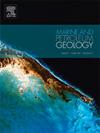Multistage fluid activity as a control on the Ediacaran carbonate reservoirs in the Sichuan Basin, SW China
IF 3.6
2区 地球科学
Q1 GEOSCIENCES, MULTIDISCIPLINARY
引用次数: 0
Abstract
The Ediacaran Dengying Formation (Z2dn) of the Sichuan Basin, Southwestern China, experienced multi-stage fluid flow, which accompanied the reduction and modification of reservoir porosity. Porosity in the Z2dn carbonate reservoir thus varies in different structural units. Fluid inclusion and implications for reservoir porosity were investigated by combining petrographic, geochemical, fluid inclusion, in-situ U-Pb geochronological, and basin modelling data. Three stages of dolomite cements (CD-1, CD-2, and CD-3) and one stage of dolomite veining (FD) were petrographically, geochemically, and geochronologically distinguished in reservoir rocks, and respectively dated at c. 453 Ma, 336 Ma, and 173 Ma. Two stages of dolomite and quartz cement formation (CD-1, CD-2, Qtz-1, and Qtz-2) were subsequently formed at c. 453 Ma, 298 Ma, 182 Ma, and 165 Ma. CD-1, CD-2 cements and FD veins were interpreted as diagenetic fluids and formed in the sealed environment during the Late Ordovician-Early Permian; they led to multi-stage cementation of reservoir intervals and a reduction in porosity. Importantly, the diagenetic sequences between bitumen and dolomite generation phases indirectly define the dates of two oil charging events. The first episode only occurred in the central Sichuan Basin during the Silurian, and its timing is constrained by the absolute ages of CD-1 and CD-2 cements. The second oil charging episode was the most important in the Sichuan Basin and occurred during Indosinian tectonics according to the trapping temperatures of bitumen-bearing inclusions in Qtz-1 veins. Also significantly, oil charge was able to inhibit the precipitation of authigenic minerals in reservoir intervals. Oil cracking in the Z2dn reservoir occurred at 173-165 Ma, accompanied by weak overpressure generation in the southeastern Sichuan Basin and medium-intensity overpressure in the central Sichuan Basin. Once again, it prevented compaction and solution compaction to maintain reservoir porosity. Moreover, CD-3 and Qtz-2 cements were possibly derived from hydrothermal fluid, which led to the dissolution of the Z2dn dolomite reservoir. As corollary, the numerous stages of dolomite cementation recorded here, the recognition of a single episode of oil charge, and weak reservoir overpressures, are the main factor contributing to a lower porosity development in the southeastern Sichuan Basin when compared to the central Sichuan Basin. These results have profound implications to the economic potential of similar oil and gas prospects deep in lower Paleozoic rocks across the world.
四川盆地埃迪卡拉系碳酸盐岩储层多级流体活动控制
四川盆地埃迪卡拉系灯影组(Z2dn)经历了多期流体流动,伴随着储层孔隙度的降低和改造。因此,Z2dn碳酸盐岩储层的孔隙度在不同的构造单元中存在差异。结合岩石学、地球化学、流体包裹体、原位U-Pb年代学和盆地建模数据,研究了流体包裹体及其对储层孔隙度的影响。在岩石学、地球化学和地质年代学上区分出3期白云岩胶结(CD-1、CD-2和CD-3)和1期白云岩脉纹(FD),其年代分别为约453 Ma、336 Ma和173 Ma。随后在约453 Ma、298 Ma、182 Ma和165 Ma形成了两个阶段的白云岩和石英胶结地层(CD-1、CD-2、Qtz-1和Qtz-2)。CD-1、CD-2胶结物和FD脉被解释为成岩流体,形成于晚奥陶世-早二叠世的封闭环境;它们导致了储层的多级胶结,降低了孔隙度。重要的是,沥青和白云岩生成阶段之间的成岩序列间接确定了两次石油充注事件的时间。第一期仅发生在四川盆地中部志留纪,其时间受CD-1和CD-2胶结物绝对年龄的限制。从Qtz-1脉体含沥青包裹体的圈闭温度来看,四川盆地的第二次充注期最为重要,发生在印支构造时期。同样显著的是,石油充注能够抑制储层中自生矿物的沉淀。Z2dn储层原油裂解发生在173 ~ 165 Ma,川东南地区形成弱超压,川中地区形成中等超压。再次,它防止了压实和溶液压实,以保持储层孔隙度。CD-3和Qtz-2胶结物可能来源于热液,导致Z2dn白云岩储层溶蚀。由此可见,川东南地区白云岩胶结期多,油气充注期单一,储层超压弱,是导致川东南地区孔隙度低于川中地区的主要因素。这些结果对世界各地下古生界深部类似油气远景的经济潜力具有深远的意义。
本文章由计算机程序翻译,如有差异,请以英文原文为准。
求助全文
约1分钟内获得全文
求助全文
来源期刊

Marine and Petroleum Geology
地学-地球科学综合
CiteScore
8.80
自引率
14.30%
发文量
475
审稿时长
63 days
期刊介绍:
Marine and Petroleum Geology is the pre-eminent international forum for the exchange of multidisciplinary concepts, interpretations and techniques for all concerned with marine and petroleum geology in industry, government and academia. Rapid bimonthly publication allows early communications of papers or short communications to the geoscience community.
Marine and Petroleum Geology is essential reading for geologists, geophysicists and explorationists in industry, government and academia working in the following areas: marine geology; basin analysis and evaluation; organic geochemistry; reserve/resource estimation; seismic stratigraphy; thermal models of basic evolution; sedimentary geology; continental margins; geophysical interpretation; structural geology/tectonics; formation evaluation techniques; well logging.
 求助内容:
求助内容: 应助结果提醒方式:
应助结果提醒方式:


